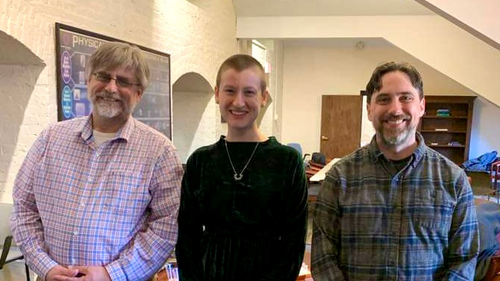
On December 12, Kimmy Cushman successfully defended the thesis, “Stealth Dark Matter with Lattice Field Theory” (advisor: George Fleming).
Kimmy explained, “Dark matter makes up about 84% of the mass of the Universe, but we still don’t know what it is or how it might interact. My research investigates a composite dark matter candidate called stealth dark matter, which would get its mass from the confinement mechanism of a new strong force. I studied the spectrum of stealth dark matter baryons using lattice field theory and developed computational tools that will allow us to eventually measure stealth dark matter self interactions which can be compared to astrophysical constraints.”
She will be transitioning to a career in sustainability and animal rights.
Thesis Abstract:
Dark matter dominates the matter content of the Universe, but its composition remains a mystery. Here, we investigate a strongly interacting SU(4) gauge theory called stealth dark matter, which is analogous to QCD in that it produces a spectrum of composite particles whose mass is generated by the strong dynamics. The lightest mass baryon of stealth dark matter is the dark matter candidate, which may naturally exhibit a self-interaction that could be compared to astrophysical constraints. This work constitutes the first milestone in the research program to calculate stealth dark matter self-interactions with lattice field theory. We present the first LapH smearing, irrep projected results of the SU(4) stealth dark matter baryon spectrum, and present the first results of the odd-parity baryon spectrum. For three points in the stealth dark matter parameter space, at three different choices of degenerate quark masses, we resolved the even-parity baryon ordering with greater precision and reduced systematic error compared to previous work.